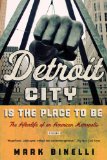Summary | Excerpt | Reviews | Beyond the Book | Readalikes | Genres & Themes | Author Bio

Critics' Opinion:
Readers' Opinion:
First Published:
Nov 2012, 336 pages
Paperback:
Nov 2013, 336 pages
 Book Reviewed by:
Book Reviewed by:
Poornima Apte
Buy This Book
Land speculators made the scene, too, as the new mayor, former Detroit Pistons basketball star Dave Bing, began to publicly acknowledge the need for the city to both shrink and radically reinvent itself, a pledge that urban-theorists, who had long regarded Detroit as the unsolvable math problem of their field, found tantalizing. And so they came, too, along with the Scandinavian academics, the neopastoralian agriculturalists, the deep-pocketed philanthropical organizations and the free-market ideologues and the fringe-left utopianists—they all came. For the most idealistic of these pioneers, which is how many of the newcomers self-identified, Detroit might very well be the city of tomorrow, but of a wholly different sort than described above. They'd come to see the place as a blank slate, so debased and forgotten it could be remade. The irony was almost too perfect: Detroit, having done more than any other city to promote the sprawl and suburbanization that had so despoiled the past century, could now become a model green city for the new century, with bike paths and urban farms and grass-roots sustainability nudging aside planned obsolescence.
So I joined the wagon train, alongside the hustlers and the do-gooders, the preachers and the criminals, the big dreamers looking to make names for themselves and the heavily armed zealots awaiting the end of the world. They—we!—came like pilgrims, to witness, to profit from, to somehow influence the story of the century. It might very well turn out to be the story of the last century, the death rattle of the twentieth-century definition of the American Dream. But there could also be another story emerging, the story of the first great postindustrial city of our new century. Who knows? Crazier things have happened in Detroit. It's a place so unspooled, one's wildest experiments, ideas that would never be seriously considered in a functioning city, might actually have a shot here. Nothing else had worked, and so everything was permitted. The ongoing catastrophes had, in a strange way, bequeathed the place an unexpected asset, something few other cities of its size possessed: a unique sense of possibility. On a psychological level, this played out as one of those instances when a hoary cliché (or, in this case, a Kris Kristofferson lyric) is basically true: having nothing left to lose really did open the mind to an otherwise tricky-to-come-by sense of freedom.
After I moved back to the city, people I met in dozens of different contexts described Detroit as "the Wild West." Meaning, it's basically lawless. Meaning, land is plentiful and cheap. Meaning, now, as the frontier quite literally returns to the city—trees growing out of tops of abandoned buildings! wild pheasants circling the empty lots!—so, too, has the metaphorical frontier, along with the notion of "frontier spirit." All possibly offensive notions to the people who'd never left, for reasons of choice or circumstance. But it's undeniable that Detroit feels like an extraordinary place, and at the same time, just as Greenland might be called ground zero of the broader climate crisis, Detroit feels like ground zero for . . . what, exactly? The end of the American way of life? Or the beginning of something else?
Either way, that is why so many divergent interests are converging here right now. Who doesn't want to see the future?
*The Big Money: "the stranger first coming to Detroit if he be interested in the busy, economic side of modern life will find a marvelous industrial beehive . . . 'detroit the city where life is worth living.' "
††The most famous shot in Sheeler's series, Criss-Crossed Conveyors, evokes neither grit nor noise but instead an almost tabernacular grace. The smokestacks in the background look like the pipes of a massive church organ, the titular conveyor belts forming the shape of what is unmistakably a giant cross. The photograph was originally published in a 1928 issue of Vanity Fair, where the caption read, "In a landscape where size, quantity and speed are the cardinal virtues, it is natural that the largest factory, turning out the most cars in the least time, should come to have the quality of America's Mecca."
Excerpted from Detroit City Is the Place to Be by Mark Binelli. Copyright © 2012 by Mark Binelli. Excerpted by permission of Metropolitan Books. All rights reserved. No part of this excerpt may be reproduced or reprinted without permission in writing from the publisher.





The House on Biscayne Bay
by Chanel Cleeton
As death stalks a gothic mansion in Miami, the lives of two women intertwine as the past and present collide.

The Flower Sisters
by Michelle Collins Anderson
From the new Fannie Flagg of the Ozarks, a richly-woven story of family, forgiveness, and reinvention.

The Funeral Cryer by Wenyan Lu
Debut novelist Wenyan Lu brings us this witty yet profound story about one woman's midlife reawakening in contemporary rural China.
Your guide toexceptional books
BookBrowse seeks out and recommends the best in contemporary fiction and nonfiction—books that not only engage and entertain but also deepen our understanding of ourselves and the world around us.